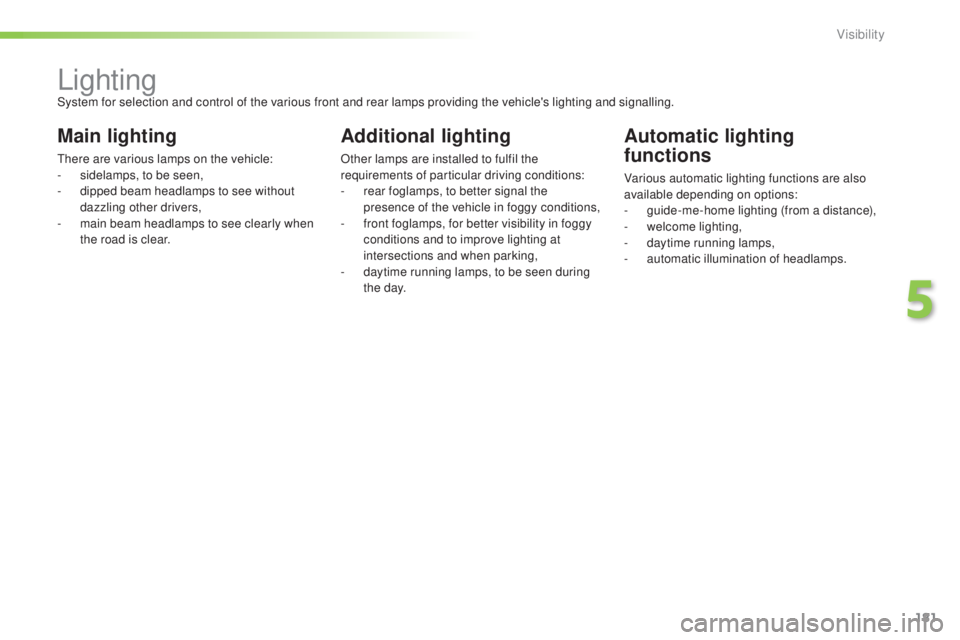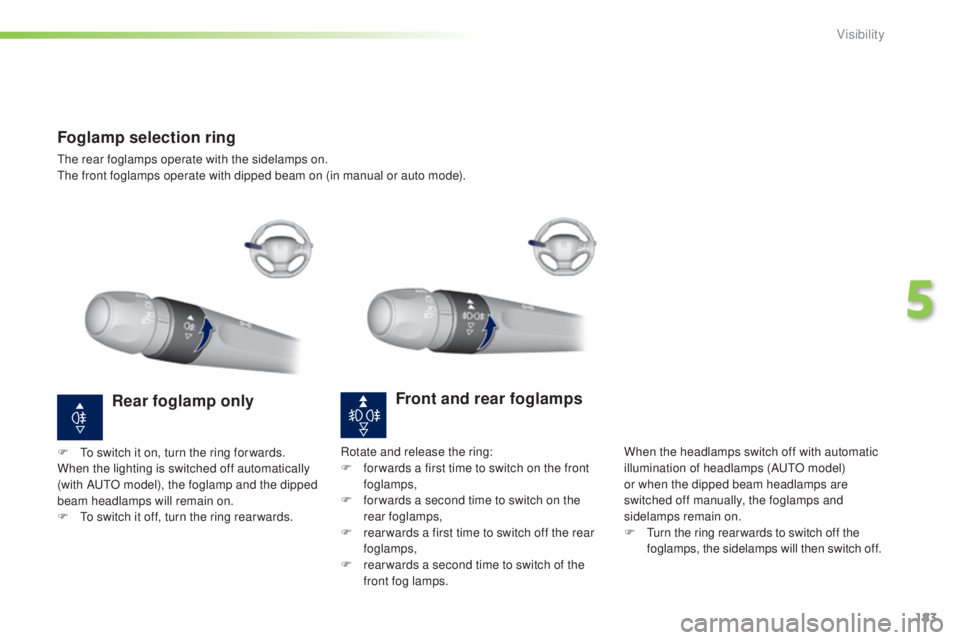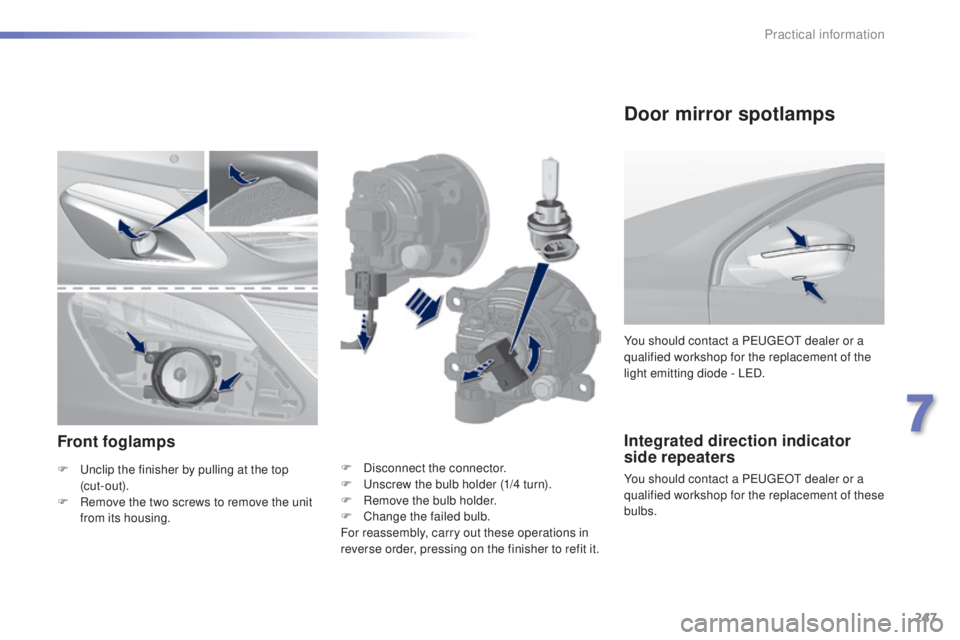2015 Peugeot 308 foglamp
[x] Cancel search: foglampPage 6 of 416

4
308_en_Chap00b_aide-visuelle_ed01-2015
exterior
W ip e r s 18 9 -19 2
Changing a wiper blade 1 92, 264
Keyless
e
n
try and
Starting remote control
5
7- 61, 65 - 67
Remote control key
5
0 -56, 67
S t a r t i n g
113 -11 9
ele
ctronic stability
programme (
e
SC)
2
01-203
Snow chains
2
42
ty
r e
pressures
2
29, 241, 296
Inder-inflation detection
1
97-200
Changing a wheel
2
35-241
-
tools
-
r
emoving / refitting
Automatic emergency braking
158-162
Lighting
181-187
Daytime running lamps (L
eD
s)
1
85
Headlamp beam adjustment
1
88
Changing bulbs 2 43-247
- f ront lamps
-
foglamps
-
d
irection indicator repeaters
Very cold climate screen
2
67
el
ectric windows, deactivation
7
3-74
Keyless e
n
try
and Starting
5
7-61
Doors
50
-53, 55
-
ope
ning / closing
-
c
entral locking
-
em
ergency control
Alarm
69-72
Fuel tank, misfuel prevention
7
6-78
Panoramic sunroof
7
5
Roof bars, bicycle carrier
2
70 -271
Accessories
2
72-273
Boot
62-64
-
ope
ning / closing
-
em
ergency release
te
mporary puncture
repair kit
2
29-234
Warning triangle
9
8
Parking sensors
1
66-168
Reversing camera
1
69
to
wbar
268-269
to
wing
265-266
Pa r k A s s i s t
17
0 -17 7
Changing bulbs
2
48-252
-
r
ear lamps
-
3
rd brake lamp
-
n
umber plate lamps
-
foglamp Door mirrors
1
78 -179, 187
Blind spot sensors
1
63 -165
Visual search
Page 12 of 416

10
308_en_Chap00c_eco-conduite_ed01-2015
Optimise the use of your gearbox
With a manual gearbox, move off gently and change up without waiting.
During acceleration change up early.
With an automatic or electronic gearbox, give preference to automatic
mode and avoid pressing the accelerator pedal heavily or suddenly.
Control the use of your electrical
equipment
Before moving off, if the passenger compartment is too warm, ventilate it
by opening the windows and air vents before using the air conditioning.
Above 30 mph (50 km/h), close the windows and leave the air vents
open.
Remember to make use of equipment that can help keep the
temperature in the passenger compartment down (sunroof and window
blinds...).
Switch off the air conditioning, unless it has automatic regulation, as
soon as the desired temperature is attained.
Switch off the demisting and defrosting controls, if not automatic.
Switch off the heated seat as soon as possible.
Switch off the headlamps and front foglamps when the level of light
does not require their use.
Avoid running the engine before moving off, particularly in winter; your
vehicle will warm up much faster while driving.
As a passenger, if you avoid connecting your multimedia devices
(film, music, video game...), you will contribute towards limiting the
consumption of electrical energy, and so of fuel.
Disconnect your portable devices before leaving the vehicle.
eco-driving
eco-driving is a range of everyday practices that allow the motorist to optimise their fuel consumption and CO2 emissions.
Drive smoothly
Maintain a safe distance between vehicles, use engine braking
rather than the brake pedal, and press the accelerator progressively.
th
ese practices contribute towards a reduction in fuel consumption
and
CO
2 emissions and also helps reduce the background traffic noise.
If your vehicle has cruise control, make use of the system at speeds
above 25 mph (40 km/h) when the traffic is flowing well.
th
e gear shift indicator invites you engage the most suitable gear: as
soon as the indication is displayed in the instrument panel, follow it
straight away.
For vehicles fitted with an electronic or automatic gearbox, this
indicator appears only in manual mode.
eco-driving
Page 16 of 416

14
308_en_Chap01_controle-de-marche_ed01-2015
Operation indicator lamps
If one of the following indicator lamps comes on in the instrument panel and/or instrument panel screen, this confirms that the corresponding system has come into operation.
Warning / indicator lamp State Cause Action / Observations
Left-hand
direction indicatorflashing with buzzer.th e lighting stalk is pushed down.
Right-hand
direction indicatorflashing with buzzer.the lighting stalk is pushed up.
Sidelamps fixed.
th
e lighting stalk is in the
"Sidelamps" position.
Dipped beam
headlamps fixed.
th
e lighting stalk is in the "Dipped
beam headlamps" position.
Main beam
headlamps fixed.
th
e lighting stalk is pulled towards
you. Pull the stalk to return to dipped beam headlamps.
Front foglamps fixed.
th
e front foglamps are switched on.
tu
rn the ring on the stalk rear wards twice to switch off
the front foglamps.
For more information on the lighting controls, refer to the corresponding section.
Monitoring
Page 17 of 416

15
308_en_Chap01_controle-de-marche_ed01-2015
Warning / indicator lamp State Cause Action / Observations
Rear foglamps fixed.
th
e rear foglamps are on.
tu
rn the ring on the stalk rear ward to switch off the
rear foglamps.
Diesel engine
pre-heating fixed.
th
e ignition switch is at the
2
nd position (ignition on) or the
ST ART/STOP button has been
pressed.Wait until the warning lamp goes off before starting.
Once it goes off, starting is immediate, on condition that:
- the clutch pedal is pressed fully down with a manual
gearbox,
- pressure is maintained on the brake pedal with an automatic gearbox.
th
e period of illumination of the warning lamp is determined by
the ambient conditions (up to about thirty seconds in extreme
conditions).
If the engine does not start, switch the ignition off and then on,
wait until the warning lamp goes off again, then start the engine.
Parking brake fixed.th e parking brake is applied or not
fully released.to s witch off the warning lamp: with your foot on the
brake pedal, release the parking brake.
If your vehicle has an electric parking brake: with your
foot on the brake pedal, push the brake control lever.
Observe the safety recommendations.
For more information on the parking brake, refer to the
corresponding section.
1
Monitoring
Page 183 of 416

181
308_en_Chap05_visibilite_ed01-2015
LightingSystem for selection and control of the various front and rear lamps providing the vehicle's lighting and signalling.
Main lighting
there are various lamps on the vehicle:
- s idelamps, to be seen,
-
d
ipped beam headlamps to see without
dazzling other drivers,
-
m
ain beam headlamps to see clearly when
the road is clear.
Additional lighting
Other lamps are installed to fulfil the
requirements of particular driving conditions:
-
r
ear foglamps, to better signal the
presence of the vehicle in foggy conditions,
-
f
ront foglamps, for better visibility in foggy
conditions and to improve lighting at
intersections and when parking,
-
d
aytime running lamps, to be seen during
t h e d ay.
Automatic lighting
functions
Various automatic lighting functions are also
available depending on options:
-
g
uide-me-home lighting (from a distance),
-
w
elcome lighting,
-
d
aytime running lamps,
-
a
utomatic illumination of headlamps.
5
Visibility
Page 185 of 416

183
308_en_Chap05_visibilite_ed01-2015
Foglamp selection ring
the rear foglamps operate with the sidelamps on.the front foglamps operate with dipped beam on (in manual or auto mode).
Front and rear foglamps
When the headlamps switch off with automatic
illumination of headlamps (Au tO m odel)
or when the dipped beam headlamps are
switched off manually, the foglamps and
sidelamps remain on.
F
t
u
rn the ring rear wards to switch off the
foglamps, the sidelamps will then switch off.
Rear foglamp only
F to switch it on, turn the ring for wards.
When the lighting is switched off automatically
(with A
u
t
O m
odel), the foglamp and the dipped
beam headlamps will remain on.
F
t
o s
witch it off, turn the ring rear wards. Rotate and release the ring:
F
f or wards a first time to switch on the front
foglamps,
F
f
or wards a second time to switch on the
rear foglamps,
F
r
ear wards a first time to switch off the rear
foglamps,
F
r
ear wards a second time to switch of the
front fog lamps.
5
Visibility
Page 186 of 416

184
308_en_Chap05_visibilite_ed01-2015
In good or rainy weather, both day
and night, the front foglamps and the
rear foglamps are prohibited. In these
situations, the power of their beams
may dazzle other drivers. t
he
y should
only be used in fog or snow.
In these weather conditions, it is your
responsibility to switch on the foglamps
and dipped headlamps manually as the
sunshine sensor may detect sufficient
light.
Do not forget to switch off the front
foglamps and the rear foglamps when
they are no longer needed.Lighting left on audible signal
An audible signal when a front door
is opened warns the driver that the
vehicle's exterior lighting is on, with the
ignition off and in manual lighting mode.
In this case, switching off the lighting
stops the audible signal.
With the ignition off, if the dipped
headlamps remain on, the vehicle goes
into "
eC
O" mode to avoid discharging
the battery. In some weather conditions (e.g. low
temperature or humidity), the presence
of misting on the internal sur face of the
glass of the headlamps and rear lamps
is normal; it disappears after the lamps
have been on for a few minutes.
th
e lighting goes off when you switch
off the ignition, but you can always
switch it on again using the lighting
control stalk.
Visibility
Page 249 of 416

247
308_en_Chap07_info-pratiques_ed01-2015
Integrated direction indicator
side repeaters
You should contact a PeugeOt dealer or a
qualified workshop for the replacement of these
bulbs. You should contact a P
e
uge
Ot
dealer or a
qualified workshop for the replacement of the
light emitting diode - L
eD
.
Front foglamps
F unclip the finisher by pulling at the top
(cut-out).
F
R
emove the two screws to remove the unit
from its housing. F
D isconnect the connector.
F un screw the bulb holder (1/4 turn).
F
R
emove the bulb holder.
F
C
hange the failed bulb.
For reassembly, carry out these operations in
reverse order, pressing on the finisher to refit it.
Door mirror spotlamps
7
Practical information